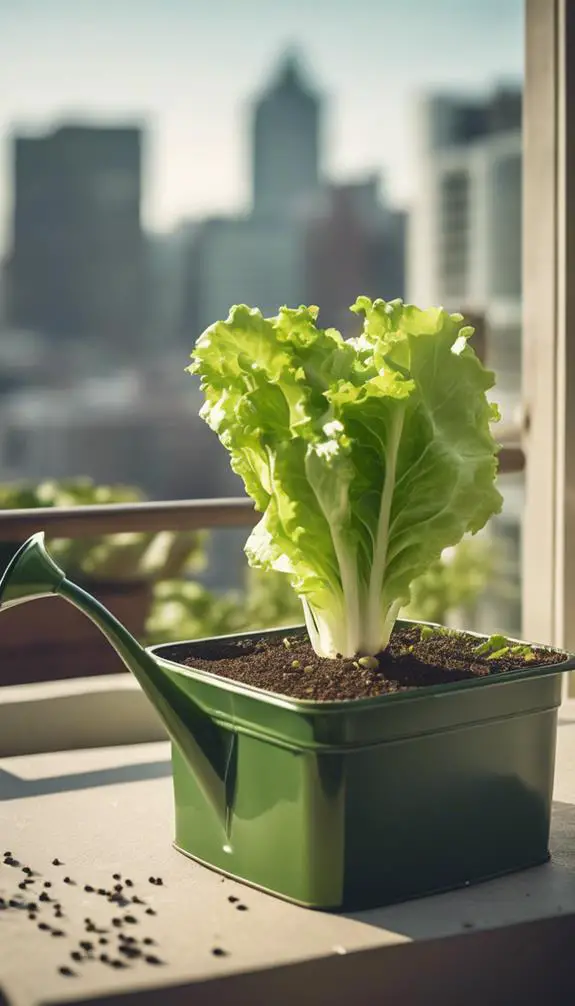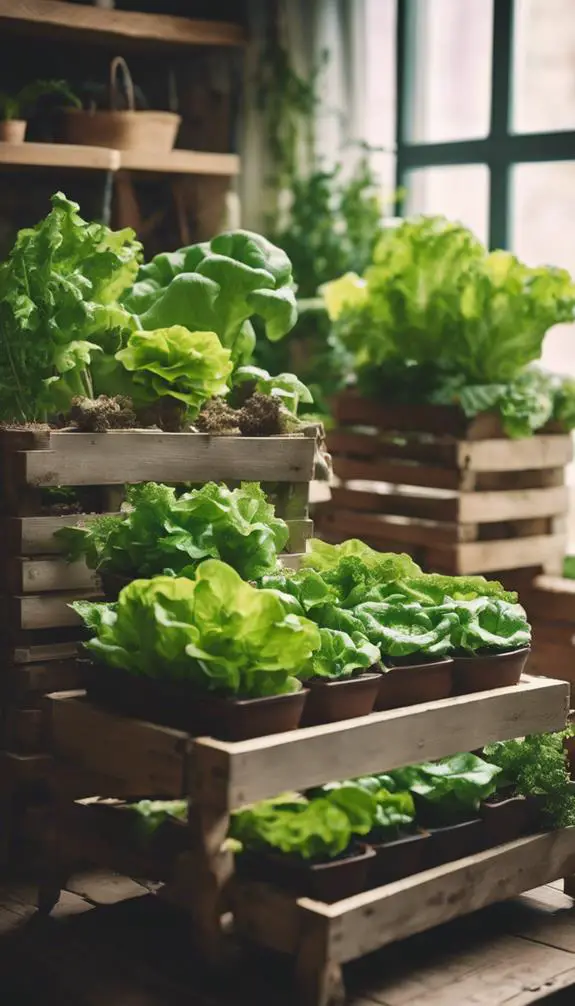You're considering growing lettuce on your balcony, and that's a great idea! Not only will you have fresh, crunchy leaves right at your fingertips, but you'll also enjoy the satisfaction of nurturing your own mini-garden. To get started, you'll need to choose the right variety of lettuce, prepare a suitable potting mix, and provide the perfect conditions for growth. But that's just the beginning – there are a few more vital steps to guarantee your lettuce thrives. What's the secret to keeping your plants healthy and disease-free, and how can you maximize your harvest?
Summary
- Select compact, productive, and disease-resistant lettuce varieties specifically bred for container growing, such as 'Red Leaf' or 'Rouge d'Hiver'.
- Ensure the container has drainage holes and a well-balanced soil mix with a pH between 6.0 and 6.5, and add compost for improved drainage and nutrients.
- Sow seeds 1/8 inch deep and 2-3 times their diameter apart, and maintain ideal watering and humidity levels for healthy germination and growth.
- Provide morning sun exposure with at least 4-6 hours of direct light, and regulate balcony temperature between 60°F and 70°F for optimal growth.
- Fertilize with a balanced fertilizer every two weeks, and implement pest and disease management strategies, such as introducing natural predators and removing infected leaves.
Choosing the Right Lettuce Variety
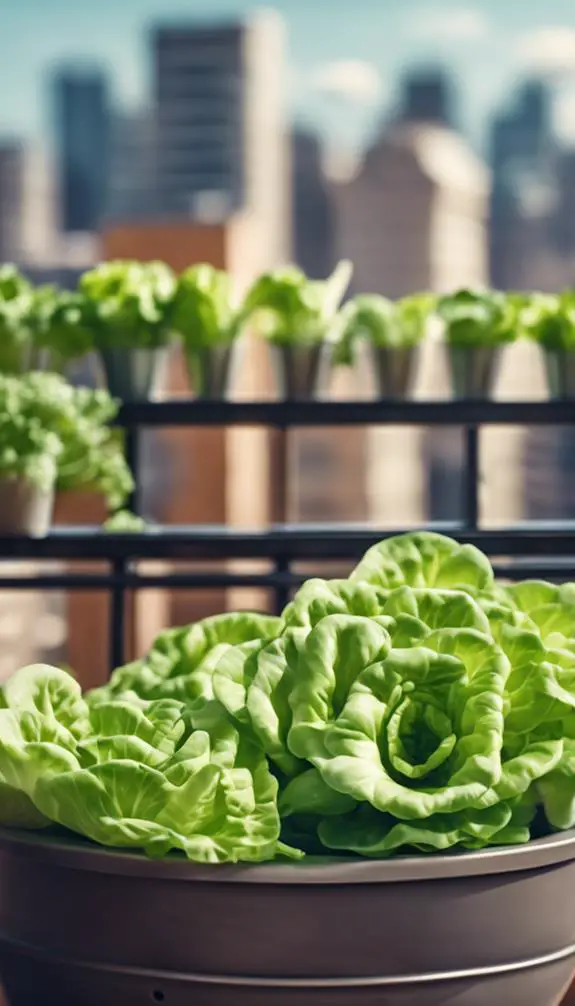
Your balcony's limited space demands a lettuce variety that's compact, productive, and resistant to bolting.
You'll want to explore lettuce history to understand the countless options available. With over 100 varieties, selecting the right one can be overwhelming.
Look for varieties bred specifically for container growing, such as 'Red Leaf', 'Green Leaf', or 'Rouge d'Hiver'. These varieties are naturally compact and produce leaves continuously.
Consider 'Buttercrunch' or 'Little Gem' for their small, dense heads and sweet flavor.
When selecting a variety, prioritize disease resistance and heat tolerance to guarantee a thriving crop.
Selecting the Perfect Container

Having chosen the perfect lettuce variety, you're now ready to select a container that will provide the ideal environment for your plants to thrive.
Consider the container size, as lettuce requires about 2-4 inches of depth and 4-6 inches of width per plant. A minimum capacity of 5-7 gallons is recommended for a decent harvest.
When it comes to material options, you have a range of choices. Plastic containers are lightweight and affordable, while ceramic or terracotta pots offer better drainage and aeration.
Wooden planters provide a natural, rustic look, but may require more maintenance. Whichever material you choose, guarantee it has drainage holes to prevent waterlogged soil.
Preparing the Soil Mixture

Most lettuce varieties thrive in well-draining, fertile soils with a pH between 6.0 and 6.5.
You'll want to test your soil pH to guarantee it falls within this range. If your soil pH is too high or too low, it can negatively impact lettuce growth. You can purchase a soil pH testing kit or send a sample to a lab for analysis.
Once you've determined your soil pH, you can adjust it if necessary. Adding compost to your soil mixture can provide numerous benefits, including improved drainage, increased nutrient availability, and a more stable pH.
Mix in a 2:1 ratio of potting soil to compost to create a well-balanced blend. This will give your lettuce the best chance to thrive in its balcony container.
Sowing Lettuce Seeds Correctly

You'll want to sow your lettuce seeds at the correct depth, as planting them too deeply can lead to poor germination or weak seedlings.
Aim for a depth of about 1/8 inch, which allows the seeds to receive adequate light without being exposed to harsh conditions.
Make sure the soil is at an ideal temperature (around 60-70°F) and has adequate moisture to promote healthy germination.
Seed Depth Matters
Sow lettuce seeds at the correct depth to give them the best chance of germination.
Proper seed placement is vital, as it affects the seed's ability to receive light, water, and oxygen.
Sow seeds about 1/8 inch deep, or 2-3 times their diameter. This allows the seeds to germinate and emerge without struggling to reach the surface.
Depth importance can't be overstated, as seeds sown too deeply may rot or fail to germinate.
Conversely, seeds sown too shallowly may be washed away or eaten by pests.
Optimal Soil Conditions
Prepare the ideal soil environment by selecting a well-draining potting mix specifically designed for containers.
This mix should have a balanced Soil pH between 6.0 and 6.5, which is perfect for lettuce growth.
Additionally, look for a mix that contains beneficial Soil Microbes, which help break down organic matter and make nutrients available to your lettuce plants.
Avoid using regular garden soil, as it can compact and prevent proper drainage in containers.
Providing Adequate Sunlight
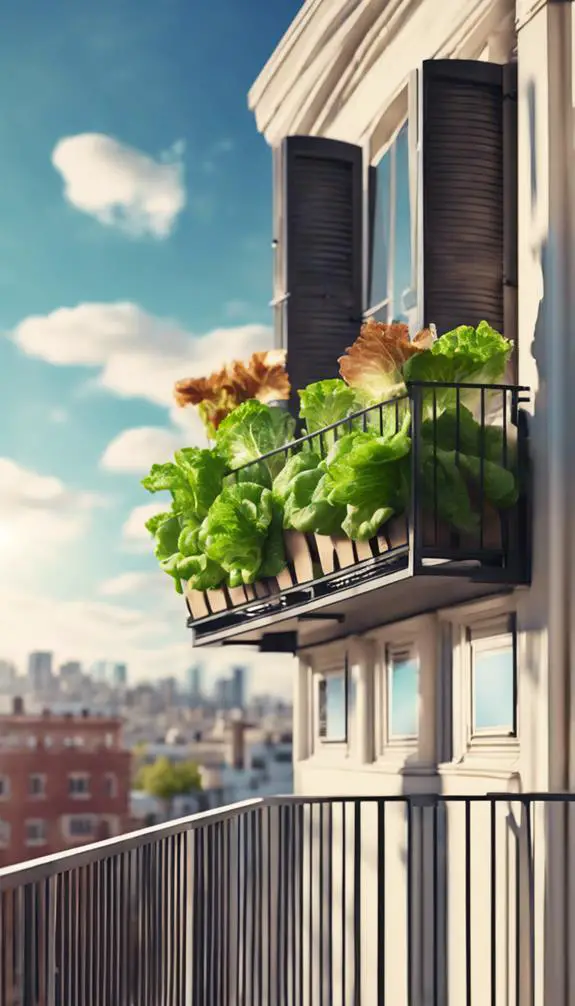
You'll want to position your lettuce plants to receive morning sun exposure, as this is when the sun's rays are gentler and more beneficial for leaf development.
Aim to provide at least 4-6 hours of direct light per day, taking into account any potential obstructions from surrounding buildings or balcony features. By doing so, you'll be creating an ideal environment for your lettuce to thrive.
Morning Sun Exposure
Your balcony's morning sun exposure plays a pivotal role in providing adequate sunlight for your lettuce plants.
In urban gardening, sunlight benefits are essential for healthy plant growth. As lettuce requires partial shade to full sun, morning sun exposure is ideal for promoting leaf development.
During this time, the sun's rays are gentler, reducing the risk of scorching the leaves. Aim to provide your lettuce plants with at least 4-6 hours of morning sun exposure.
This will stimulate photosynthesis, leading to robust and flavorful lettuce. By maximizing morning sun exposure, you'll be well on your way to a thriving balcony garden.
Direct Light Duration
Its south-facing orientation allows your balcony to capture the direct light essential for lettuce growth, and understanding the ideal duration is crucial.
Aim for at least 4-6 light hours of direct sunlight daily, as lettuce requires a minimum of 12 hours of total light exposure to thrive. Consider your sun orientation and adjust your lettuce placement accordingly.
East- or west-facing balconies can receive indirect sunlight for a shorter duration, while north-facing balconies may require supplemental lighting. Monitor the sun's movement and adjust your lettuce's position to maximize direct light exposure.
Watering and Humidity Control
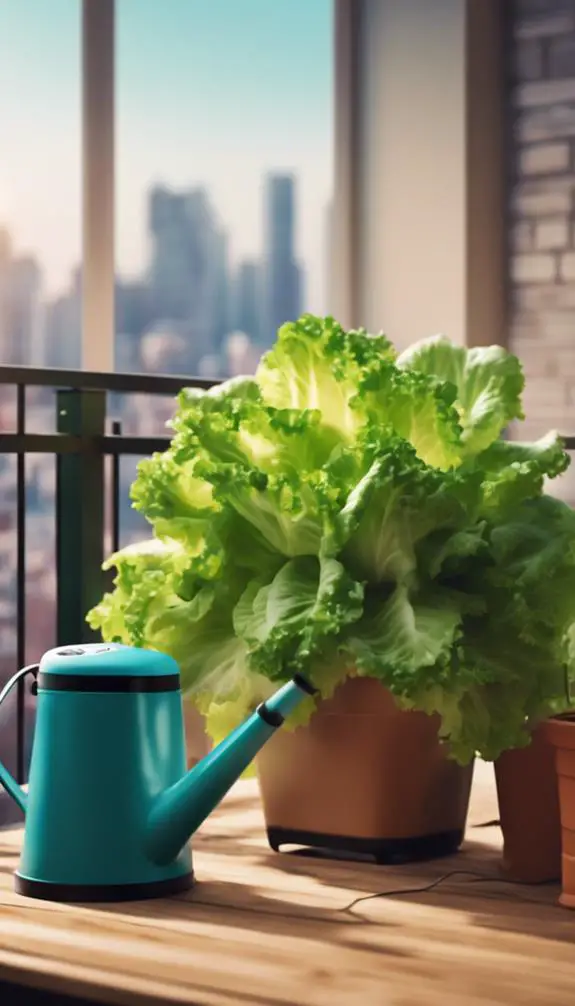
As the lettuce plants begin to thrive on your balcony, maintaining ideal watering and humidity levels becomes crucial for their continued growth and health.
You'll want to guarantee the soil is consistently moist but not waterlogged, which can be achieved by using moisture meters to monitor the soil's water content. Aim for a reading between 20-40% moisture.
To maintain peak humidity, consider investing in humidity domes or cloches that fit over individual plants or entire planters. These will help retain moisture and regulate air circulation.
Balcony Temperature Considerations

Balcony temperature substantially impacts lettuce growth, so it's vital to monitor and regulate it.
You'll need to guarantee your balcony doesn't get too hot or cold, as lettuce prefers temperatures between 60°F and 70°F (15°C and 21°C).
Cold snaps can damage or kill your lettuce, so be prepared to provide protection if the temperature drops.
Temperature fluctuation can also hinder growth, so try to maintain a consistent temperature.
Consider using a thermometer to track temperature changes and adjust your lettuce's position accordingly.
If you live in an area with extreme temperatures, consider using a balcony cover or bringing your lettuce inside during the night to regulate the temperature.
Fertilizing Your Lettuce Plants

Three to four weeks after sowing your lettuce seeds, it's time to fertilize your lettuce plants.
At this stage, your lettuce is in its germination and seedling growth stage. You'll want to provide a balanced fertilizer with a nitrogen-phosphorus-potassium (NPK) ratio of 10-10-10. This will promote healthy leaf development and support the plant's growth.
Follow a fertilizer schedule of once every two weeks to guarantee consistent nutrient supply. You can use a water-soluble fertilizer, and dilute it to half the recommended strength to avoid burning your lettuce's roots.
As your lettuce reaches its maturity stage, you can adjust the fertilizer schedule accordingly.
Pest and Disease Prevention

While fertilizing your lettuce plants, you're also creating an environment that can attract pests and diseases.
To prevent this, maintain good garden hygiene by removing weeds and debris that can harbor pests. Implement flea control measures, such as introducing natural predators like ladybugs or lacewings, which feed on aphids and whiteflies.
Set up bug traps near your plants to capture and eliminate unwanted insects. Regularly inspect your plants for signs of disease like fungal growth, yellowing leaves, or black spots.
Treat fungal diseases with organic fungicides, and remove infected leaves to prevent the disease from spreading. By being proactive, you can protect your lettuce plants from pests and diseases, ensuring a healthy and bountiful harvest.
Thinning and Pruning Lettuce

You'll need to thin and prune your lettuce plants to promote healthy growth and encourage the production of crisp, flavorful leaves.
When selecting leaves to remove, choose those that are weak, damaged, or overcrowding the container, as these can compromise the overall health of the plant.
Lettuce Leaf Selection
Within a few days of sowing, your lettuce seeds will germinate, and the seedlings will start competing for space, light, and nutrients.
As they grow, you'll notice variations in leaf quality and texture.
To guarantee optimal results, identify and select the healthiest seedlings with desirable traits.
Look for leaves with a crisp, tender texture and a vibrant green color.
Avoid seedlings with wilted, yellow, or deformed leaves, as they may be more prone to disease or pests.
Proper Pruning Techniques
Now that you've selected the healthiest seedlings, it's time to focus on pruning techniques to optimize your lettuce growth.
Thinning and pruning lettuce encourages bushy growth, prevents overcrowding, and promotes even distribution of nutrients.
To maintain a neat lettuce shape, remove weak or spindly growth, and trim leaves to about 1-2 inches from the soil.
Establish a pruning schedule to prune your lettuce every 2-3 days, or when leaves reach 4-6 inches tall.
This stimulates new growth and prevents the plant from flowering.
Supporting Lettuce Plants Vertically
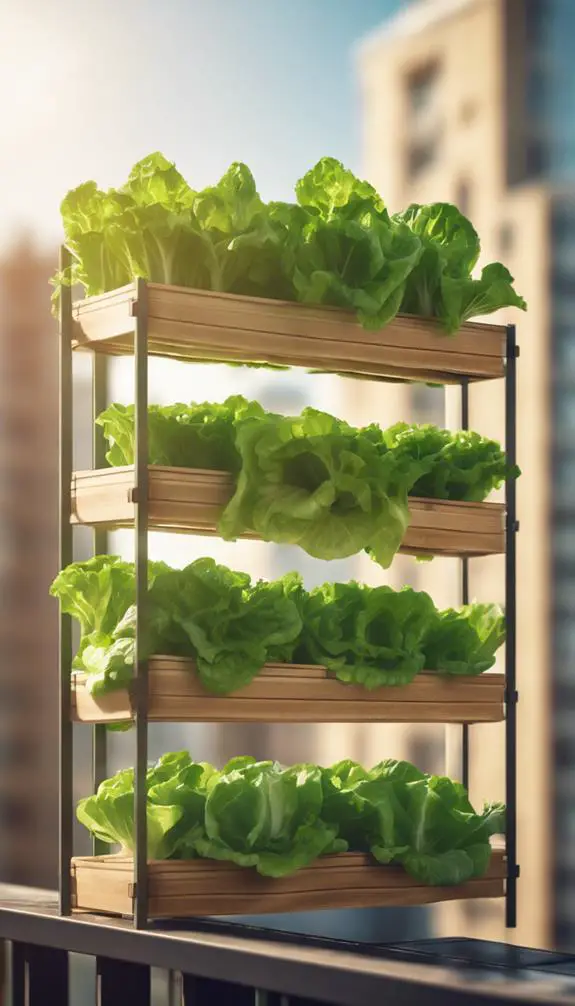
Two to three lettuce plants can thrive in a single vertical spot, maximizing your balcony's space.
By using vertical planters, you can increase your yield without sacrificing precious floor space. These space savers allow you to make the most of your balcony's dimensions, making them ideal for urban gardeners.
When selecting a vertical planter, look for one with good drainage and a sturdy structure to support the weight of the plants. You can also use a trellis or a cage to provide additional support as the plants grow.
Monitoring Growth and Health
Your lettuce plants' growth and health require regular monitoring to guarantee a successful harvest.
Perform lettuce inspections daily to catch any potential issues early on. Examine the leaves for signs of stress, pests, or disease, such as yellowing, wilting, or holes.
Check the soil moisture by sticking your finger into the soil up to the first knuckle. Make sure the soil is consistently moist but not waterlogged.
Leaf examination is vital, so gently lift the leaves to inspect the undersides for any hidden issues.
Regular monitoring enables you to take prompt action to address any problems, ensuring your lettuce plants thrive and produce a healthy, abundant harvest.
Harvesting Fresh Lettuce Leaves

One of the most rewarding aspects of growing lettuce on your balcony is harvesting the fresh, crisp leaves.
You'll know it's time to harvest when the leaves reach 2-3 inches in length and the plant has formed a rosette shape.
Use scissors to cut the leaves about an inch above the soil line, leaving the stem and roots intact to encourage further leaf formation.
Harvesting in the morning, when leaves are at their crispest, will guarantee maximum lettuce nutrition.
Take only what you need, as this will encourage the plant to produce more leaves.
Regular harvesting will also prevent the plant from flowering and going to seed.
FAQs
Can I Grow Lettuce on a Balcony With Partial Shade?
You can grow lettuce in partial shade, but be aware that most varieties require at least 4-6 hours of direct sunlight daily. Check the specific light requirements and shade tolerance of the lettuce type you're growing to guarantee superior results.
Will Lettuce Plants Attract Bees or Other Pollinators?
You'll be pleased to know that lettuce plants are low-maintenance pollinator attractants, but they won't attract bees in droves; however, incorporating bee-friendly plants like lavender or coneflowers nearby can create a pollinator-friendly oasis that'll draw these beneficial insects.
Can I Grow Lettuce in a Balcony With Strong Winds?
You'll need to provide wind protection for your lettuce plants on a windy balcony; consider using a windbreak or attaching a screen to the balcony railing to create a sheltered microclimate, ensuring ideal growing conditions.
How Often Should I Rotate My Lettuce Containers?
You should rotate your containers every 3-5 days to guarantee ideal growth, considering root depth and leaf orientation, as consistent exposure to sunlight and wind promotes healthy development and prevents lopsided growth.
Can I Use a Self-Watering Planter for Lettuce?
You can utilize a self-watering planter, which optimizes water conservation by storing excess water for later use, ensuring consistent soil moisture levels, and reducing the risk of overwatering, allowing you to grow healthy lettuce with minimal maintenance.
Conclusion
You've successfully grown lettuce on your balcony by following these guidelines. Now, enjoy your fresh, crisp harvest. Continue to monitor growth, prune regularly, and fertilize every two weeks to encourage continuous production. With proper care, your lettuce plants will thrive, providing you with a bountiful supply of healthy greens throughout the growing season.


